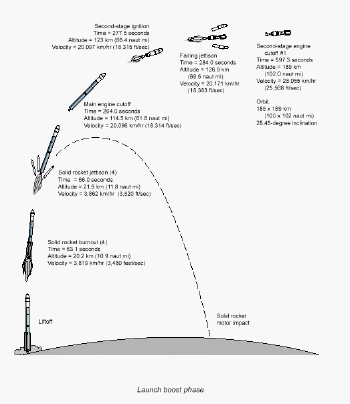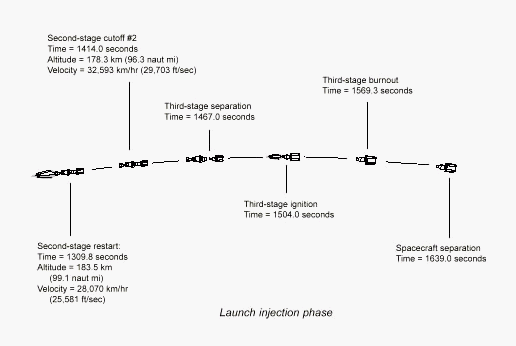
STARDUST Launch Sequence Diagrams

STARDUST Boost ProfileLaunch occurs in three phases, consisting of liftoff and insertion into a 189-kilometer (102-mile) parking orbit; a coast of about a half hour until the vehicle position is properly aligned relative to the direction it must leave Earth; and final injection to an escape trajectory. The total time needed to complete the process is a little under an hour.
Sixty-six seconds after liftoff, the four solid rocket motors will be discarded while the first stage continues to burn. About 4 minutes, 24 seconds after liftoff, the first stage will stop firing and be discarded eight seconds later. About five seconds later, the second stage engine ignites. The fairing or nose-cone enclosure of the launch vehicle will be discarded 4 minutes, 42 seconds after liftoff. The first burn of the rocket's second stage ends about 11 minutes, 22 seconds after liftoff.

STARDUST Injection PhaseAbout 21 minutes after launch, the second stage will restart. At about 24 minutes into the flight, the third stage will separate and burn for about two minutes, after which the Stardust spacecraft will separate from the third stage and begin its first orbit of the Sun.
Immediately after separation from the Delta's third stage, Stardust will stop its own spinning by firing its thrusters. About 4 minutes after separation, the spacecraft's solar array will be unfolded and be pointed toward the Sun. Shortly thereafter, the 34-meter-diameter (112-foot) antenna at the Deep Space Network complex in Canberra, Australia will acquire Stardust's signal.
Ron Baalke, STARDUST Webmaster, ron@jpl.nasa.gov
Wednesday, 26-Nov-2003 12:46:43 PST